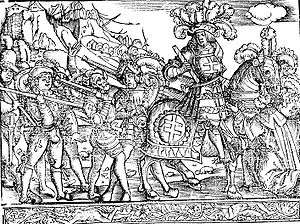Nancy, France
Nancy (/ˈnænsi/ NAN-see, also UK: /ˈnɒ̃si/, US: /nɒ̃ˈsiː, ˈnɑːnsi/,[2][3][4] French: [nɑ̃si]; German: Nanzig [ˈnantsiç]) is the capital of the north-eastern French department of Meurthe-et-Moselle, and formerly the capital of the Duchy of Lorraine, and then the French province of the same name. The metropolitan area of Nancy had a population of 434,565 inhabitants at the 2011 census, making it the 20th largest urban area in France. The population of the city of Nancy proper was 104,321 in 2014.[5]
Nancy | |
|---|---|
Prefecture and commune | |
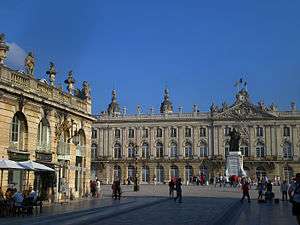 Place Stanislas in the centre of town | |
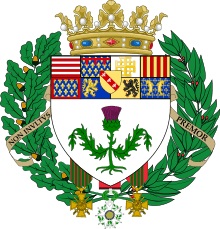 Coat of arms | |
| Motto(s): | |
Location of Nancy 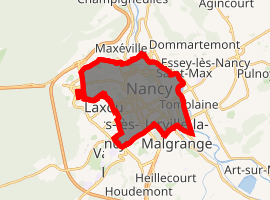
| |
 Nancy 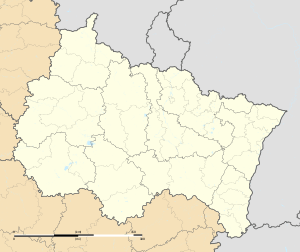 Nancy | |
| Coordinates: 48°41′37″N 6°11′05″E | |
| Country | France |
| Region | Grand Est |
| Department | Meurthe-et-Moselle |
| Arrondissement | Nancy |
| Canton | 3 cantons |
| Intercommunality | Métropole du Grand Nancy |
| Government | |
| • Mayor (2020–2026) | Mathieu Klein |
| Area 1 | 15.01 km2 (5.80 sq mi) |
| Population (2017-01-01)[1] | 104,286 |
| • Density | 6,900/km2 (18,000/sq mi) |
| Time zone | UTC+01:00 (CET) |
| • Summer (DST) | UTC+02:00 (CEST) |
| INSEE/Postal code | 54395 /54000 |
| Elevation | 188–353 m (617–1,158 ft) (avg. 212 m or 696 ft) |
| Website | http://www.nancy.fr/ |
| 1 French Land Register data, which excludes lakes, ponds, glaciers > 1 km2 (0.386 sq mi or 247 acres) and river estuaries. | |
| Part of the series on |
| Lorraine |
|---|
 Flag of Lorraine since the 13th century |
|
|
|
Administrative divisions
|
|
Lorraine in the EU |
|
Related topics |
The motto of the city is Non inultus premor, Latin for '"I am not injured unavenged"'[6]—a reference to the thistle, which is a symbol of Lorraine.
Place Stanislas, a large square built between March 1752 and November 1755 by Stanislaus I of Poland to link the medieval old town of Nancy and the new town built under Charles III in the 17th century, is a UNESCO World Heritage Site, the first place in France and in the top four in the world.
History
The earliest signs of human settlement in the area date to 800 BC. Early settlers were likely attracted by easily mined iron ore and a ford in the Meurthe River. Its name is first attested as Nanciaco, possibly from a Gaulish personal name. A small fortified town named Nanciacum (Nancy) was built by Gérard, Duke of Lorraine around 1050.
Nancy was burned in 1218 at the end of the War of Succession of Champagne, and conquered by Emperor Frederick II. It was rebuilt in stone over the next few centuries as it grew in importance as the capital of the Duchy of Lorraine. Duke Charles the Bold of Burgundy, was defeated and killed in the Battle of Nancy in 1477; René II, Duke of Lorraine became the ruler.
Following the failure of both Emperor Joseph I and Emperor Charles VI to produce a son and heir, the Pragmatic Sanction of 1713 left the throne to the latter's next child. This turned out to be a daughter, Maria Theresa of Austria. In 1736, Emperor Charles arranged her marriage to Duke François of Lorraine, who reluctantly agreed to exchange his ancestral lands for the Grand Duchy of Tuscany.
The exiled Polish king Stanisław Leszczyński, father-in-law of the French king Louis XV, was then given the vacant duchy of Lorraine. Under his nominal rule, Nancy experienced growth and a flowering of Baroque culture and architecture. Stanislaus oversaw the construction of Place Stanislaus, a major square and development connecting the old medieval with a newer part of the city. Upon Stanisław's death in February 1766, Lorraine and Barrois became a regular government of the Kingdom of France.[7] A parlement for Lorraine and Barrois was established in Nancy in 1776.[7]
As unrest surfaced within the French armed forces during the French Revolution, a full-scale mutiny, known as the Nancy affair, took place in Nancy in the latter part of summer 1790. A few units loyal to the government laid siege to the town and shot or imprisoned the mutineers.
In 1871, Nancy remained French when Prussia annexed Alsace-Lorraine. The flow of refugees reaching Nancy doubled its population in three decades. Artistic, academic, financial and industrial excellence flourished, establishing what is still the Capital of Lorraine's trademark to this day.
Nancy and other areas of France were occupied by German forces from 1940, renamed Nanzig. During the Lorraine Campaign of World War II, Nancy was liberated from Nazi Germany by the U.S. Third Army in September 1944, at the Battle of Nancy.
In 1988, Pope John Paul II visited Nancy. In 2005, French President Jacques Chirac, German Chancellor Gerhard Schröder, and Polish President Aleksander Kwaśniewski inaugurated the renovated Place Stanislas. It is recognized as a UNESCO World Heritage Site.
Geography
Nancy is situated on the left bank of the river Meurthe, about 10 km upstream from its confluence with the Moselle. The Marne–Rhine Canal runs through the city, parallel to the Meurthe. Nancy is surrounded by hills that are about 150 m higher than the city center, which is situated at 200 m above mean sea level. The area of Nancy proper is relatively small: 15 km2. Its built-up area is continuous with those of its adjacent suburbs. The neighboring communes of Nancy are: Jarville-la-Malgrange, Laxou, Malzéville, Maxéville, Saint-Max, Tomblaine, Vandœuvre-lès-Nancy and Villers-lès-Nancy.
The oldest part of Nancy is the quarter Vieille Ville – Léopold, which contains the 14th century Porte de la Craffe, the Palace of the Dukes of Lorraine, the Porte Désilles and the 19th century St-Epvre basilica. Adjacent to its south is the quarter Charles III – Centre Ville, which is the 16th–18th century "new town". This quarter contains the famous Place Stanislas, the Nancy Cathedral, the Opéra national de Lorraine and the main railway station.
The population of the city proper experienced a small decrease in population from 2009 to 2014, placing it behind Metz (117,619) as the second largest city in the Lorraine.[5][8] However, the urban area of Metz experienced population decline from 1990 to 2010 while the urban area of Nancy grew over the same period, becoming the largest urban area in Lorraine and second largest in the "Grand Est" region of northeastern France. Within the Nancy metropolitan area in recent years, the city population declined slightly (2009–2014) at the roughly same time as a small increase in the population of its urban area (2006–2012).
Climate
Nancy has an oceanic climate (Köppen: Cfb), although a bit more extreme than most of the larger French cities.[9] By the standards of France it is a "continental" climate with a certain degree of maritimy (unrelated to the Köppen classification, since generally the whole country has a predominant mechanism favored by the West winds).[10][11]
The temperatures have a distinct variation of the temperate zone, both during the day and between seasons but without being very different. Winters are cold and dry in freezing climates. Summers are not always sunny, but warm enough. Mists are frequent in autumn and the winds are light and not too violent. Precipitation tends to be less abundant than in the west of the country. Sunshine hours are almost identical to Paris and the snowy days are the same as Strasbourg (most similar weather conditions).[12] Although the lowest recorded temperature is officially −26.8 °C, some sources consider temperatures from −30 °C on 10 December 1879 before continuous data.[13]
| Climate data for Nancy-Tomblaine (Les Ensanges), elevation: 217 m or 712 ft, 1961–1990 normals | |||||||||||||
|---|---|---|---|---|---|---|---|---|---|---|---|---|---|
| Month | Jan | Feb | Mar | Apr | May | Jun | Jul | Aug | Sep | Oct | Nov | Dec | Year |
| Record high °C (°F) | 16.8 (62.2) |
20.0 (68.0) |
24.3 (75.7) |
29.3 (84.7) |
32.5 (90.5) |
36.1 (97.0) |
40.1 (104.2) |
39.3 (102.7) |
33.7 (92.7) |
27.2 (81.0) |
22.1 (71.8) |
18.5 (65.3) |
40.1 (104.2) |
| Average high °C (°F) | 4.6 (40.3) |
6.4 (43.5) |
10.9 (51.6) |
14.8 (58.6) |
19.2 (66.6) |
22.6 (72.7) |
25.1 (77.2) |
24.7 (76.5) |
20.3 (68.5) |
15.1 (59.2) |
8.9 (48.0) |
5.4 (41.7) |
14.9 (58.8) |
| Average low °C (°F) | −0.8 (30.6) |
−0.7 (30.7) |
2.0 (35.6) |
4.1 (39.4) |
8.4 (47.1) |
11.7 (53.1) |
13.7 (56.7) |
13.2 (55.8) |
10.1 (50.2) |
6.8 (44.2) |
2.8 (37.0) |
0.4 (32.7) |
6.0 (42.8) |
| Record low °C (°F) | −21.6 (−6.9) |
−26.8 (−16.2) |
−15.9 (3.4) |
−6.8 (19.8) |
−4.2 (24.4) |
1.6 (34.9) |
2.0 (35.6) |
2.8 (37.0) |
−1.3 (29.7) |
−7.9 (17.8) |
−12.7 (9.1) |
−21.3 (−6.3) |
−26.8 (−16.2) |
| Average precipitation mm (inches) | 65.4 (2.57) |
55.3 (2.18) |
59.5 (2.34) |
49.3 (1.94) |
67.6 (2.66) |
69.2 (2.72) |
62.4 (2.46) |
63.0 (2.48) |
64.7 (2.55) |
73.8 (2.91) |
65.9 (2.59) |
79.0 (3.11) |
775.1 (30.52) |
| Average precipitation days | 11.2 | 9.5 | 10.6 | 9.3 | 11.0 | 9.9 | 9.6 | 9.2 | 9.2 | 11.4 | 11.6 | 11.8 | 124.3 |
| Mean monthly sunshine hours | 55.9 | 79.7 | 129.1 | 173.9 | 199.1 | 220.9 | 229.1 | 213.7 | 162.8 | 104.8 | 51.7 | 44.3 | 1,664.9 |
| Source: Météo France[14][15] | |||||||||||||
| Climate data for Nancy-Tomblaine (Les Ensanges), elevation: 217 m or 712 ft, 1961–1990 normals and extremes | |||||||||||||
|---|---|---|---|---|---|---|---|---|---|---|---|---|---|
| Month | Jan | Feb | Mar | Apr | May | Jun | Jul | Aug | Sep | Oct | Nov | Dec | Year |
| Record high °C (°F) | 14.6 (58.3) |
19.4 (66.9) |
24.3 (75.7) |
27.6 (81.7) |
29.2 (84.6) |
33.9 (93.0) |
37.6 (99.7) |
36.3 (97.3) |
32.6 (90.7) |
27.2 (81.0) |
20.8 (69.4) |
18.5 (65.3) |
37.6 (99.7) |
| Mean maximum °C (°F) | 8.1 (46.6) |
12.6 (54.7) |
13.9 (57.0) |
17.1 (62.8) |
21.6 (70.9) |
26.2 (79.2) |
29.2 (84.6) |
26.4 (79.5) |
24.6 (76.3) |
16.8 (62.2) |
12.3 (54.1) |
8.5 (47.3) |
29.2 (84.6) |
| Average high °C (°F) | 4.2 (39.6) |
5.8 (42.4) |
9.5 (49.1) |
13.7 (56.7) |
17.9 (64.2) |
21.1 (70.0) |
23.3 (73.9) |
23.1 (73.6) |
20.1 (68.2) |
15.1 (59.2) |
8.1 (46.6) |
4.9 (40.8) |
13.9 (57.0) |
| Daily mean °C (°F) | 1.7 (35.1) |
2.5 (36.5) |
5.3 (41.5) |
8.6 (47.5) |
12.5 (54.5) |
15.8 (60.4) |
17.8 (64.0) |
17.6 (63.7) |
14.7 (58.5) |
10.4 (50.7) |
5.1 (41.2) |
2.1 (35.8) |
9.5 (49.1) |
| Average low °C (°F) | −0.9 (30.4) |
−0.7 (30.7) |
1.0 (33.8) |
3.7 (38.7) |
7.4 (45.3) |
10.8 (51.4) |
12.1 (53.8) |
12.1 (53.8) |
9.7 (49.5) |
6.3 (43.3) |
2.0 (35.6) |
−0.6 (30.9) |
5.2 (41.4) |
| Mean minimum °C (°F) | −7.1 (19.2) |
−8.3 (17.1) |
−2.2 (28.0) |
1.9 (35.4) |
5.7 (42.3) |
8.6 (47.5) |
10.2 (50.4) |
10.2 (50.4) |
5.9 (42.6) |
2.3 (36.1) |
−1.1 (30.0) |
−4.7 (23.5) |
−8.3 (17.1) |
| Record low °C (°F) | −21.6 (−6.9) |
−19 (−2) |
−15.9 (3.4) |
−6.1 (21.0) |
−2.9 (26.8) |
2.2 (36.0) |
2.0 (35.6) |
2.8 (37.0) |
−1.2 (29.8) |
−6 (21) |
−10.2 (13.6) |
−19 (−2) |
−21.6 (−6.9) |
| Average precipitation mm (inches) | 57.8 (2.28) |
48.4 (1.91) |
59.0 (2.32) |
44.9 (1.77) |
70.1 (2.76) |
72.6 (2.86) |
55.3 (2.18) |
56.5 (2.22) |
56.3 (2.22) |
52.5 (2.07) |
60.4 (2.38) |
67.2 (2.65) |
701 (27.62) |
| Average precipitation days (≥ 1.0 mm) | 13.0 | 10.0 | 12.0 | 10.0 | 11.5 | 9.5 | 7.5 | 9.0 | 8.5 | 9.0 | 11.5 | 12.5 | 124 |
| Average snowy days | 8.0 | 6.7 | 4.5 | 1.8 | 0.1 | 0.0 | 0.0 | 0.0 | 0.0 | 0.1 | 3.4 | 6.1 | 30.7 |
| Average relative humidity (%) | 87 | 83 | 78 | 74 | 75 | 75 | 75 | 77 | 81 | 86 | 87 | 87 | 80 |
| Mean monthly sunshine hours | 45.4 | 80.9 | 120.8 | 160.3 | 197.5 | 215.5 | 241.9 | 212.9 | 164.4 | 108.4 | 58.0 | 45.6 | 1,651.6 |
| Percent possible sunshine | 17.0 | 29.0 | 33.0 | 39.0 | 42.0 | 45.0 | 50.0 | 49.0 | 44.0 | 33.0 | 21.0 | 18.0 | 35.0 |
| Source 1: NOAA[16] | |||||||||||||
| Source 2: Infoclimat.fr (humidity)[17] | |||||||||||||
Main sights

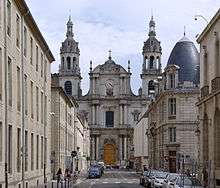

The old city center's heritage dates from the Middle Ages to the 18th century. The cathedral of Nancy, the Triumphal Arch and the "Place de la Carriere" are a fine examples of 18th-century architecture.[18] The Palace of the Dukes of Lorraine is the former princely residence of the rulers. The palace houses the Musée Lorrain.
A historic church is the Church of Notre-Dame-de-Bonsecours, Nancy, final resting place of the last duke Stanislas. Other notable churches are the Church of Saint-François-des-Cordeliers and the Basilica of Saint-Epvre (fr:Basilique Saint-Epvre de Nancy), which have historical ties to the ducal House of Lorraine.
The Place Stanislas[19] named after king of Poland and duke of Lorraine Stanislaus I, Place de la Carrière, and Place d'Alliance were added on the World Heritage Sites list by the UNESCO in 1983.
The "École de Nancy", a group of artists and architects founded by the glassmaster and furniture maker Émile Gallé, worked in the art nouveau style at the end of the 19th century and the early 20th century. It was principally their work which made Nancy a center of art and architecture that rivaled Paris and helped give the city the nickname "Capitale de l'Est". The city still possesses many Art Nouveau buildings (mostly banks or private homes). Furniture, glassware, and other pieces of the decorative arts are conserved at the Musée de l'École de Nancy, which is housed in the 1909 villa of Eugène Corbin, a Nancy businessman and supporter of the Art Nouveau there. The Musée des Beaux-Arts has further collections of the art nouveau movement.
A major botanical garden, the Jardin botanique du Montet, is located at Villers-lès-Nancy. Other gardens of interest include the city's earliest botanical garden, the Jardin Dominique Alexandre Godron, and various other public gardens and places of interest including the Pépinière and Parc Sainte-Marie (public gardens). The town also has an aquarium.
The surroundings of the train station are a busy commercial area.
Culture
.jpg)
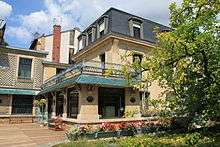
The city is known for its World Heritage buildings at the Place Stanislas, which was opened April 2005 by Jacques Chirac after refurbishment.
At the turn of the 20th century, Nancy was a major center of the Art Nouveau with the École de Nancy. The city possesses a unique and interesting Musée de l'École de Nancy (School of Nancy Museum) with artworks by Émile Gallé, Louis Majorelle, Daum, Caravaggio,[20] and others.
Nancy also has other museums:
- Museum of Fine Arts of Nancy (Musée des Beaux-Arts de Nancy) with painters from the 15th to 20th centuries, and a huge collection of Daum crystal displayed in part of the old fortifications of the city.
- Lorraine History Museum dedicated to the history of the Duchy of Lorraine and arts (Jacques Callot collection, Georges de La Tour).
- Aquarium and Natural History Museum of Nancy.
- Musée de l'École de Nancy offers a testimony of the diversity of creative techniques practiced by the artists of this school, with a fine display of furniture, objets d'art, glassware, stained-glass, leather, ceramics, textiles, etc. from the period.[21]
- The Iron History Museum[22]
The city is also the seat of the Diocese of Nancy and the home of the Opéra national de Lorraine. There is a network of libraries, the central of which is Bibliothèque municipale de Nancy.
Nancy is known for its macarons and bergamotes, candies flavored with bergamot essential oil.
Universities and colleges
Nancy has a large number of institutions of higher learning.
- University of Lorraine which merges:
- Henri Poincaré University (Université Henri Poincaré, UHP, also known as Nancy 1)[23]
- Nancy 2 University (Université Nancy 2)[24]
- National Polytechnic Institute of Lorraine (Institut National Polytechnique de Lorraine or INPL)
- École nationale supérieure des Mines de Nancy
- École nationale supérieure des industries chimiques (ENSIC)
- École nationale supérieure d'agronomie et des industries alimentaires (ENSAIA)
- École européenne d'ingénieurs en génie des matériaux (EEIGM)
- École nationale supérieure d'électricité et de mécanique (ENSEM)
- École nationale supérieure de géologie (ENSG)
- École nationale supérieure en génie des systèmes industriels (ENSGSI)
- Telecom Nancy (ex-ESIAL)
- École Supérieure des Sciences et Technologies de l'Ingénieur de Nancy (ESSTIN)
- École des Beaux-Arts de Nancy
- École nationale supérieure d’art de Nancy
- School of architecture of Nancy (ENSA)
- École pour l'informatique et les nouvelles technologies (EPITECH)
- ICN Graduate Business School (Institut Commercial de Nancy)
- Sciences Po Paris (French-German Undergraduate Campus)[25]
- Centre de Nancy-AgroParisTech[26]
- École Supérieure Robert de Sorbon
- French National School of Forestry, est. 1824, in Nancy
- Web@cademie
Sports
Nancy is home to two of the three professional sport clubs in Lorraine: AS Nancy-Lorraine in football and SLUC Nancy in basketball. AS Nancy-Lorraine's Hall of Fame includes triple-Ballon d'Or and UEFA President Michel Platini, Arsenal manager Arsène Wenger, 1998 World Champion Aimé Jacquet, 2000 European Champion Roger Lemerre, 1998 African Ballon d'Or Mustapha Hadji, Irish legend Tony Cascarino, 1986 European Cup winner Sacha Zavarov and 1958 World Cup Semi-finalist Roger Piantoni.
AS Nancy-Lorraine won the French cup 1978 with captain Michel Platini who scored the only goal of the final (Nancy 1–0 Nice). More recently AS Nancy-Lorraine won the "Coupe de la Ligue" (French League Cup) in 2006 and reached fourth place in the French football league in 2007/2008.
SLUC Nancy won the last Korac European Cup in 2002, reached the finals of French championship of basketball (Pro A) four consecutive times and finally won his first trophy in 2008. Also winner of "Semaine des As" in 2005 and champion of 2nd league (pro B) in 1994.
Winner of the 2010–2011 French Championship.
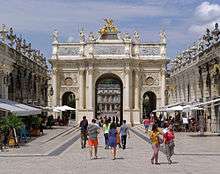

Native sons and daughters
Nancy was the birthplace of:
- François-Émile André (1871–1933), architect
- Marie Henri d'Arbois de Jubainville (1827–1910), historian and philologist
- Charles Baudiot (1773–1849), cellist and composer
- Najoua Belyzel (born 1981), singer
- André Bernanose (1912–2002), chemist, physicist and pharmacologist
- Jean Galli de Bibiena (1709–1779), playwright
- René-Prosper Blondlot (1849–1930), physicist, best remembered for his mistaken identification of N rays
- Jacques Callot (c. 1592–1635), baroque graphics artist, draftsman and printmaker
- Henri Cartan (1904–2008), mathematician
- Paul Colin (1892–1985), poster artist
- Grand Duchess Christina of Tuscany (1565–1637)
- Gérard Cuny (1925–1996), French gerontologist
- Matthieu Delpierre (born 1981), footballer
- Auguste Digot (1815–1864), historian of Lorraine
- Antoine Drouot (1774–1847), one of Napoleon's generals
- Joseph Ducreux (1735–1802), portrait painter, pastelist, miniaturist, and engraver
- Prosper Guerrier de Dumast (1796–1883), proponent of Lotharingism
- Pascal Dusapin (born 1955), composer
- Lucien Febvre (1878–1956), historian
- Adèle Ferrand (1817–1848), painter
- Francis I, Holy Roman Emperor (1708–1765), duke of Lorraine and later Holy Roman Emperor
- Émile Gallé (1846–1904), Art Nouveau artist
- Edmond de Goncourt (1822–1896), author, critic, publisher, founder of the Académie Goncourt
- Jean-Baptiste Isabey (1767–1855), painter
- François Jacob (1920–2013), biologist Won the 1965 Nobel Prize in Medicine.
- Yves Lambert (born 1936), aerospace engineer
- Nicolas Liebault (1723–1795), collaborator of the Encyclopédie by Diderot and D’Alembert
- Hubert Lyautey (1854–1934), Marshal of France
- Louis Maimbourg (1610–1686), Jesuit and historian
- Aimé Morot (1850–1913), painter
- Charles Palissot de Montenoy (1730–1814), playwright
- Michel Picard (born 1931), writer, winner of the 2007 Feuille d'or de la ville de Nancy
- Michel Platini (b. 1955 in Jœuf), footballer
- Henri Poincaré (1854–1912), mathematician, theoretical scientist and philosopher of science
- Éric Rohmer (1920–2010), film director
- Pierre Roussel (epigrapher) (1881–1945), archaeologist and epigrapher
- Henri Royer (1869–1938), painter
- Jean François de Saint-Lambert (1716–1803), poet
- Pierre Schaeffer (1910–1995), noted as the inventor of musique concrète
- Charles Sellier, (1830–1882) painter
- José Touré (born 1961) footballer
- Arnaud Vincent (born 1974), motorcycle racer
- Élise Voïart, (1786–1866) writer and translator
- Lucien Weissenburger (1860–1929), architect
- Maxime Chanot (born 1990), footballer
- Pierre Deladonchamps (born 1 June 1978), actor: A Childhood (Une Enfance), Stranger by the Lake (L'Inconnu du Lac)
Transport
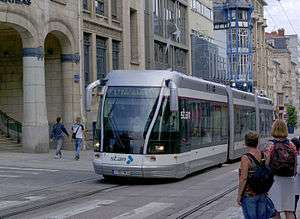
The main railway station is Gare de Nancy-Ville, with direct connections to Paris (high-speed rail line), Metz, Lyon, Strasbourg and several regional destinations. The motorway A31 connects Nancy with Metz, Luxembourg and Langres.
Public transport within Nancy is provided by Service de Transport de l'Agglomération Nancéienne (STAN),[27] operated by Veolia Transport, operating the Tram by STAN and around 20 conventional bus routes.
The most heavily used route, the Tram T1, is a so-called 'tramway on tires', which is actually a guided busway based on Bombardier Transportation's Guided Light Transit (GLT) technology and using articulated trolleybuses. In addition to diesel buses, Nancy has been served by trolleybuses since 1982, but in 2000 the three-route trolleybus system was reconfigured into a single, longer route and with a surface guidance system added (GLT, or TVR in French). The guidance systems covers about two-thirds of the approximately 10-km route, and the trolleybuses are separated from other traffic over that portion of the route, speeding travel times. During its first two years, the new system suffered many incidents and malfunctions of the guidance system, but now works without significant problems.
Heraldry

The coat of arms of Nancy displays a thistle, originally considered to be a symbol of Virgin Mary, and adopted as a personal symbol by René of Anjou and later by his descendant René II, Duke of Lorraine. Contrary to the Scottish thistle, the one of Lorraine is always shown with its roots. During the wars against Burgundy, the thistle became an emblem for the people of Lorraine as a whole. It officially became the attribute of the city of Nancy in 1575 when Charles III, Duke of Lorraine granted the city with its own coat of arms.[28]
At first, the coat of arms of Nancy had a chief of Lorraine, which meant that the upper part showed the ducal arms, namely three alerions on a red bend. Later, the chief of Lorraine was replaced by a more complex one which gathers the former possessions of the Dukes of Lorraine. The upper row comprises from left to right the arms of the Kingdom of Hungary, the Kingdom of Naples, the Kingdom of Jerusalem and the Kingdom of Aragon, while the lower row comprises the Duchy of Anjou, the Duchy of Guelders, the Duchy of Jülich and the County of Bar. The inescutcheon is the coat of arms of Lorraine itself.[28]
The coat of arms displays the motto, which appeared in the end of the 16th century. It was initially "Nul ne s'y frotte" ("no one attacks it"), but it was changed to Latin "Non inultus premor" in 1616. The motto has a similar meaning to the Scottish one, "Nemo me impune lacessit", usually translated as "No one attacks me with impunity", which also makes reference to the thistle. The coat of arms further displays the Legion of Honour, awarded to the city after the First World War, and the War Crosses 14–18 and 39–45.[28]
See also
- N ray, a figment of local physicist René-Prosper Blondlot's imagination, named for Nancy.
- Parc naturel régional de Lorraine
- The great organ of Nancy Cathedral
- List of twin towns and sister cities in France
Notes
- "Populations légales 2017". INSEE. Retrieved 6 January 2020.
- "Nancy". The American Heritage Dictionary of the English Language (5th ed.). Boston: Houghton Mifflin Harcourt. Retrieved 10 May 2019.
- "Nancy". Collins English Dictionary. HarperCollins. Retrieved 10 May 2019.
- "Nancy" (US) and "Nancy". Oxford Dictionaries UK Dictionary. Oxford University Press. Retrieved 10 May 2019.
- "Populations légales 2014, Commune de Nancy (54395)" (in French). INSEE. Retrieved 1 March 2018.
- Latin Proverbs: Wisdom from Ancient to Modern Times.
- The Encyclopædia Britannica, p. 12.
- "Comparateur de territoire, Commune de Metz (57463)". INSEE. Retrieved 1 March 2018.
- "Nancy, France Köppen Climate Classification (Weatherbase)". Weatherbase. Retrieved 28 March 2019.
- "France Climats". houot.alain.pagesperso-orange.fr. Retrieved 28 March 2019.
- "France – Climate". Encyclopædia Britannica. Retrieved 28 March 2019.
- "Climat et météo de Nancy (54000)". linternaute.com. Retrieved 28 March 2019.
- "Année 1879, almanach météo complet des ères géologiques à nos jours". prevision-meteo.ch. Archived from the original on 21 August 2016. Retrieved 29 March 2019.
- "Données climatiques de la station de Nancy" (in French). Meteo France. Archived from the original on 4 March 2016. Retrieved 8 January 2016.
- "Climat Lorraine" (in French). Meteo France. Archived from the original on 3 March 2016. Retrieved 8 January 2016.
- "Nancy-Tomblaine (07180) – WMO Weather Station". NOAA. Retrieved 28 March 2019. Archived 28 March 2019, at the Wayback Machine.
- "Normes et records 1961–1990: Nancy-Essey (54) – altitude 212m" (in French). Infoclimat. Archived from the original on 9 January 2016. Retrieved 8 January 2016.
- "History and heritage – Nancy Tourisme". nancy-tourisme.fr. Archived from the original on 21 May 2013. Retrieved 29 April 2018.
- Images of the Place Stanislas Archived 26 May 2007 at the Wayback Machine
- "Annunciation" painted 1608, Musée des Beaux-Arts
- "The Ecole de Nancy Museum – Nancy Tourisme". nancy-tourisme.fr. Archived from the original on 18 February 2013. Retrieved 29 April 2018.
- "Musée de l'histoire du fer". nancy-tourisme.fr. Retrieved 11 October 2019.
- "Université de Lorraine". uhp-nancy.fr. Archived from the original on 29 July 2016. Retrieved 29 April 2018.
- "Université de Lorraine". univ-nancy2.fr. Archived from the original on 24 February 2015. Retrieved 29 April 2018.
- "Campus de Nancy – Sciences Po Collège universitaire". franco-allemand.sciences-po.fr. 23 February 2017. Archived from the original on 19 September 2009. Retrieved 29 April 2018.
- Paris, Guillaume. "Centre de Nancy – AgroParisTech". agroparistech.fr. Archived from the original on 2 December 2014. Retrieved 29 April 2018.
- "Stan : Page d'accueil". reseau-stan.com. Archived from the original on 24 February 2011. Retrieved 29 April 2018.
- "Origine du blason de Nancy". Nancy WebTV. Archived from the original on 11 February 2017. Retrieved 11 February 2017.
Bibliography
- The Encyclopædia Britannica. XVII (11th ed.). 1911.
External links
| Wikimedia Commons has media related to Nancy. |
| Wikivoyage has a travel guide for Nancy. |
- City council website (in French)
- Tourist office website
- Nancy Convention bureau (in French)
- Place Stanislas Live Webcam
- Phonebook of Nancy
- "Young European Federalists in Nancy and around in Lorraine" (in French). Archived from the original on 17 May 2012. Retrieved 1 October 2006.
- Jardin botanique du Montet (Botanical Garden) (in French)
- Art Nouveau-related links
